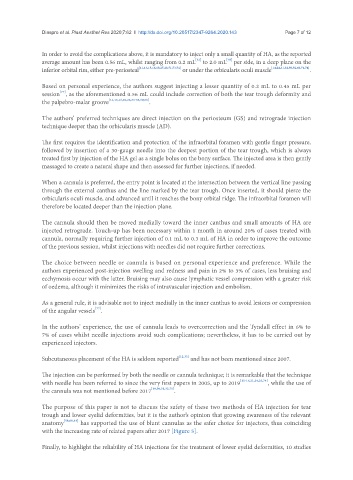Page 731 - Read Online
P. 731
Diaspro et al. Plast Aesthet Res 2020;7:62 I http://dx.doi.org/10.20517/2347-9264.2020.143 Page 7 of 12
In order to avoid the complications above, it is mandatory to inject only a small quantity of HA, as the reported
[12]
[48]
average amount has been 0.56 mL, whilst ranging from 0.2 mL to 2.0 mL per side, in a deep plane on the
inferior orbital rim, either pre-periosteal [11,13,15,16,19,27,48,71,73,74] or under the orbicularis oculi muscle [14,24,31,32,50,52,66,71,74] .
Based on personal experience, the authors suggest injecting a lesser quantity of 0.2 mL to 0.45 mL per
[77]
session , as the aforementioned 0.56 mL could include correction of both the tear trough deformity and
the palpebro-malar groove [11,13,16,20,22,30-32,60,61] .
The authors’ preferred techniques are direct injection on the periosteum (GS) and retrograde injection
technique deeper than the orbicularis muscle (AD).
The first requires the identification and protection of the infraorbital foramen with gentle finger pressure,
followed by insertion of a 30-gauge needle into the deepest portion of the tear trough, which is always
treated first by injection of the HA gel as a single bolus on the bony surface. The injected area is then gently
massaged to create a natural shape and then assessed for further injections, if needed.
When a cannula is preferred, the entry point is located at the intersection between the vertical line passing
through the external canthus and the line marked by the tear trough. Once inserted, it should pierce the
orbicularis oculi muscle, and advanced until it reaches the bony orbital ridge. The infraorbital foramen will
therefore be located deeper than the injection plane.
The cannula should then be moved medially toward the inner canthus and small amounts of HA are
injected retrograde. Touch-up has been necessary within 1 month in around 20% of cases treated with
cannula, normally requiring further injection of 0.1 mL to 0.3 mL of HA in order to improve the outcome
of the previous session, whilst injections with needles did not require further corrections.
The choice between needle or cannula is based on personal experience and preference. While the
authors experienced post-injection swelling and redness and pain in 2% to 3% of cases, less bruising and
ecchymosis occur with the latter. Bruising may also cause lymphatic vessel compression with a greater risk
of oedema, although it minimizes the risks of intravascular injection and embolism.
As a general rule, it is advisable not to inject medially in the inner canthus to avoid lesions or compression
of the angular vessels .
[77]
In the authors’ experience, the use of cannula leads to overcorrection and the Tyndall effect in 6% to
7% of cases whilst needle injections avoid such complications; nevertheless, it has to be carried out by
experienced injectors.
Subcutaneous placement of the HA is seldom reported [12,33] and has not been mentioned since 2007.
The injection can be performed by both the needle or cannula technique; it is remarkable that the technique
with needle has been referred to since the very first papers in 2005, up to 2019 [11-16,21,24,33,74] , while the use of
the cannula was not mentioned before 2017 [19,30,31,52,71] .
The purpose of this paper is not to discuss the safety of these two methods of HA injection for tear
trough and lower eyelid deformities, but it is the author’s opinion that growing awareness of the relevant
anatomy [58,60,61] has supported the use of blunt cannulas as the safer choice for injectors, thus coinciding
with the increasing rate of related papers after 2017 [Figure 5].
Finally, to highlight the reliability of HA injections for the treatment of lower eyelid deformities, 10 studies

